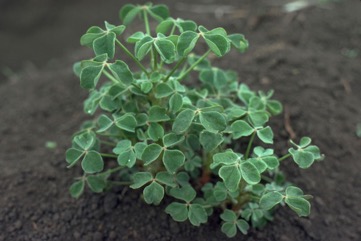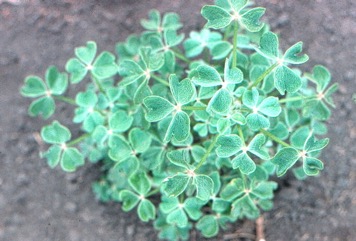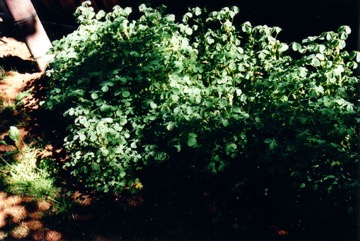Oca

A temperate plant. It mostly grows in the Andes from Colombia to Chile at between 3,500 and 3,800 m altitude. The plant is frost hardy. They grow in the high altitude tropics. (2,800 - 4,560 m in the Andes). In Argentina it grows between 1,200-2,800 m above sea level. In the hot tropical lowlands, tubers perish quickly. A daylength of 9 hours is best for tuber formation. Vegetative top growth occurs under long day lengths. It suits hardiness zones 7-11.
Also known as:
New Zealand yam, Peru, Samoa, Oqa, Apio blanca, Cuiba, Cuiva, Huisisai, Ibias, Macachin, Miquichi, Quiba, Ok'a, Apilla, Ibia, Ruba, Timbo, Quiba, Papa roja, Papa colorada, Papa extranjera, Truffette acide
Synonyms
- Oxalis crenata Jacq.
- Oxalis crassicaulis Zuccarini
- Oxalis arracacha G. Don
Edible Portion
- Flowers, Leaves, Root, Tubers, Vegetable
Where does Oca grow?
Found in: Andes, Argentina, Australia, Bolivia, Britain, Central America, Chile, Colombia, Ecuador, Mexico, New Zealand, North America, Pacific, Papua New Guinea, PNG, Peru, South America, Tasmania, United States, Venezuela
Notes: There are about 500 Oxalis species.
Status: It is a commercially cultivated vegetable. "Stew without chunu is like life without love!" It has only recently been introduced to Papua New Guinea to try it out. It is an important food in high altitude areas in the Andes.
Growing Oca
Cultivation: Plants are grown from tubers or cut pieces of tubers which contain 1-3 eyes. Planting is normally done at the beginning of the rainy season and plants are weeded and soil mounded around them. A spacing of 20-40 cm x 20-36 cm is recommended.
Edible Uses: The tubers are acid when fresh but are dried slightly then cooked and eaten. The bitter kinds are freeze dried and stored for later use. They can be used in soups and stews. The young leaves and shoots can be eaten. CAUTION Fresh tubers contain calcium oxalate.
Production: Tubers mature in about 8 months. Average yields in the Andes are about 3.7 t / ha. After digging tubers are cured in the sun for several days.
Nutrition Info
per 100g edible portion| Edible Part | Energy (kcal) | Protein (g) | Iron (mg) | Vitamin A (ug) | Vitamin c (mg) | Zinc (mg) | % Water |
|---|---|---|---|---|---|---|---|
| Tubers | 61 | 2.1 | - | - | - | - | 83.4 |
Oca Photos



References
Castillo, R. O., 1995, Plant Genetic Resources in the Andes: Impact, Conservation, and Management. Crop Science 35:355-360
Cheifetz, A., (ed), 1999, 500 popular vegetables, herbs, fruits and nuts for Australian Gardeners. Random House p 83
Crawford, M., 2012, How to grow Perennial Vegetables. Green Books. p 141
Cundall, P., (ed.), 2004, Gardening Australia: flora: the gardener's bible. ABC Books. p 966
Facciola, S., 1998, Cornucopia 2: a Source Book of Edible Plants. Kampong Publications, p 165
Food Composition tables for International use http://www.fao.org/vegetables No. 76
Franquemont, C., et al, 1990, The Ethnobotany of Chinchero, an Andean Community in Southern Peru. Fieldiana Botany No. 24 p 81
French, B.R., 1986, Food Plants of Papua New Guinea, A Compendium. Asia Pacific Science Foundation p 22
Hedrick, U.P., 1919, (Ed.), Sturtevant's edible plants of the world. p 456 (Also as Oxalis crassicaulis)
Hermandez Bermejo, J.E., and Leon, J. (Eds.), 1994, Neglected Crops. 1492 from a different perspective. FAO Plant Production and Protection Series No 26. FAO, Rome. p 20, 151
Hibbert, M., 2002, The Aussie Plant Finder 2002, Florilegium. p 216
Kay, D.E., 1973, Root Crops, Digest 2, Tropical Products Institute, London, p 96
Kays, S. J., and Dias, J. C. S., 1995, Common Names of Commercially Cultivated Vegetables of the World in 15 languages. Economic Botany, Vol. 49, No. 2, pp. 115-152
Kermath, B. M., et al, 2014, Food Plants in the Americas: A survey of the domesticated, cultivated and wild plants used for Human food in North, Central and South America and the Caribbean. On line draft. p 599
Kiple, K.F. & Ornelas, K.C., (eds), 2000, The Cambridge World History of Food. CUP p 1824
Lim, T. K., 2015, Edible Medicinal and Non Medicinal Plants. Volume 9, Modified Stems, Roots, Bulbs. Springer p 62
Macbride. J. F., 1949, Flora of Peru. Geraniaceae. Field Museum Natural History. Chicago. p 545
Macmillan, H.F. (Revised Barlow, H.S., et al), 1991, Tropical Planting and Gardening. Sixth edition. Malayan Nature Society. Kuala Lumpur. p 365
Martin, F.W. & Ruberte, R.M., 1979, Edible Leaves of the Tropics. Antillian College Press, Mayaguez, Puerto Rico. p 209
Morley, B. & Everard, B., 1970, Wild Flowers of the World. Ebury press. Plate 171
Plants for a Future database, The Field, Penpol, Lostwithiel, Cornwall, PL22 0NG, UK. http://www.scs.leeds.ac.uk/pfaf/
PROSEA handbook Volume 9 Plants yielding non-seed carbohydrates. p 177
Purseglove, J.W., 1968, Tropical Crops Dicotyledons, Longmans. p 638
Sag. stor. nat. Chili 132. 1782
Schneider, E., 2001, Vegetables from Amaranth to Zucchini: The essential reference. HarperCollins. p 425
Smith, K., 1998. Growing Uncommon Fruits and Vegetables. New Holland. p 31
Smith, N., Mori, S.A., et al, 2004, Flowering Plants of the Neotropics. Princeton. p 283
Smith, P.M., 1979, Oca, in Simmonds, N.W., (ed), Crop Plant Evolution. Longmans. London. p 317
Solomon, C., 2001, Encyclopedia of Asian Food. New Holland. p 414
Tapia, M. E., The role of under-utilised plant species with regard to increased food security and improved health of poor poeople, in mountain regions. IIAP-PNUD/Peru
Terra, G.J.A., 1973, Tropical Vegetables. Communication 54e Royal Tropical Institute, Amsterdam, p 64
USDA, ARS, National Genetic Resources Program. Germplasm Resources Information Network - (GRIN). [Online Database] National Germplasm Resources Laboratory, Beltsville, Maryland. Available: www.ars-grin.gov/cgi-bin/npgs/html/econ.pl (10 April 2000)
van Wyk, B., 2005, Food Plants of the World. An illustrated guide. Timber press. p 271
Wikipedia
World Checklist of Useful Plant Species 2020. Royal Botanic Gardens, Kew